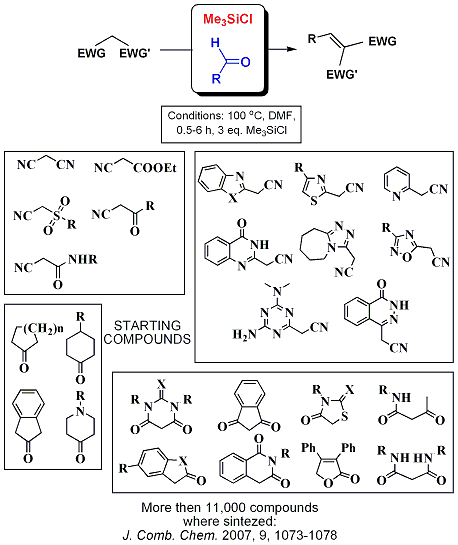Examples of scientific projects at ChemBiocenter
Development of new procedures for combinatorial chemistry
One of the modern methods of finding chemical compounds possessing desirable biological activity (the so-called "hits") is high-throughput screening (HTS). The method is based on express-tests of biological activity, which allow determination of the activity for thousands of compounds per day. Using this method, one can identify hits by screening large arrays (so-called "libraries") of chemical compounds. For many years, the limitation of this approach was the availability of the libraries. How to synthesize thousands of compounds per day, sufficiently pure and in the amount required for biological testing (1-50 mg)? Only 20 years ago, an army of synthetic chemists would be required to do this, but now the synthesis could be done by one person, or even by a robot. The development of methods and technology of combinatorial chemistry – this is what made such a synthesis possible.
The main idea behind the combinatorial chemistry consists in carrying out, mainly automated, all the possible reactions between starting reagents. For example, if the target compound is synthesized in two steps and one can use 100 reagents at each step, there is a theoretical possibility to synthesize 10000 different compounds. An analogous three-step process can give a library of 1000000 chemical compounds. In practice, this possibility became a reality with the advent of an original technology, which employs methods of solid phase synthesis, invented by Bruce Merrifield in 1960th. There is a very important requirement to the reactions which are used in combinatorial chemistry: they should be fast and clean, providing the products sufficiently pure without additional purification. Not every chemical reaction is suitable for the purposes of combinatorial chemistry; therefore, the search for new clean and fast reactions, optimizing the conditions for them is highly important.
One of the procedure developed at the ChemBioCenter extended the scope of the well-studied Knoewenagel reaction. This procedure is based on the use of trimethylchlorosilane (TMSCl) as the reagent. Carrying out the reaction in specially designed sealed Pyrex tubes allowed synthesizing libraries of very diverse chemical compounds. The procedure led to the compounds hardly available by other methods, for example, 2-oxymethylene-, chloro- and bromovinyl-substituted heterocyclic compounds, 1,2-condensed tetrahydroquinoline-3-carboxylic acids, diverse purine derivatives. The work is illustrated by the following scheme:

TMSCl turned out extremely efficient for promoting multi-component reactions. These reactions are of special value for combinatorial chemistry, as they allow synthesis of complex molecules by simultaneous formation of several chemical bonds in one step, without isolation of intermediates. The scientists at ChemBioCenter optimized the Biginelly reaction promoted by TMSCl (see the scheme below) for combinatorial chemistry and synthesized a library of tetrahydropyrimidine-2[1H]-thiones and hexahydro-5H-pyrimido-[5,4-e][1,3]-thiazine-5-ones (Org. Lett. 2007, 9, 4215-4218).
![The scientists at ChemBioCenter optimized the Biginelly reaction promoted by TMSCl for combinatorial chemistry and synthesized a library of tetrahydropyrimidine-2[1H]-thiones and hexahydro-5H-pyrimido-[5,4-e][1,3]-thiazine-5-ones. The scientists at ChemBioCenter optimized the Biginelly reaction promoted by TMSCl for combinatorial chemistry and synthesized a library of tetrahydropyrimidine-2[1H]-thiones and hexahydro-5H-pyrimido-[5,4-e][1,3]-thiazine-5-ones.](/upload/chembiocenter_2.gif)
Molecular Modeling
The main task of the Molecular Modeling Department at ChemBioCenter is development of methodology and computer programs for rational drug design. Advances in this area considerably shortened the time needed for identification of new drug candidates.
By the use of modern computer approaches, it is possible to elucidate mechanisms of biological action of chemical compounds. The so-called "virtual screening" of compounds against biological targets became a reality. Calculation of certain physical and chemical parameters (ADME-Tox) helps in planning the synthesis of new chemical compounds for biological testing.
At the ChemBioCenter, the majority of calculations is done by the Schrodinger - the program which contains all modern algorithms for virtual screening. However, the scientists of the Molecular Modeling Department developed original algorithms and corresponding programs, which is reflected in the publications.
One of the examples of the rational drug design is the collaboration between ChemBioCenter and Howard University (USA), aimed at finding compounds capable of interfering the interaction of Tat-peptide (Tat HIV-1) and protein phosphatase 1 (PP1). This interaction was proposed as a biological target to achieve inhibiting of HIV replication. As the result of the virtual screening of 300000 compounds, 146 compounds were identified as potential micromolar inhibitors of HIV replication. Following biological testing showed that some of the 146 compounds in fact inhibit the replication of the virus in cells. The results were presented at the XVII international AIDS Conference, and won the first prize for the best fundamental research. Optimization of the compounds for in vivo testing is in progress.

Synthesis of Nanostructures
Chemists at the ChemBioCenter developed a simple procedure of synthesis of nanostructures – molecular Russian Dolls. NMR spectroscopy showed that six molecular bowls of calyx[4]resorcinolarenes and eight molecules of water form nano-capsule which intercalates a molecular bowl of calyx[4]arene. The latter, in turn, intercalates tetramethylammoniun cation and one molecule of water (see the figure below).

|